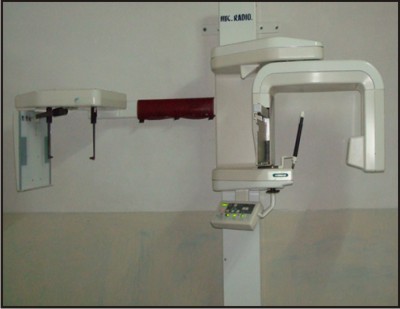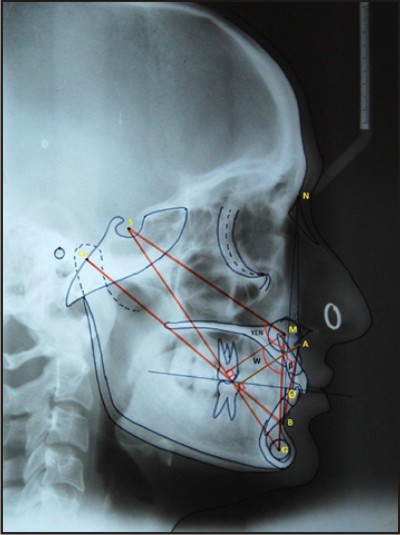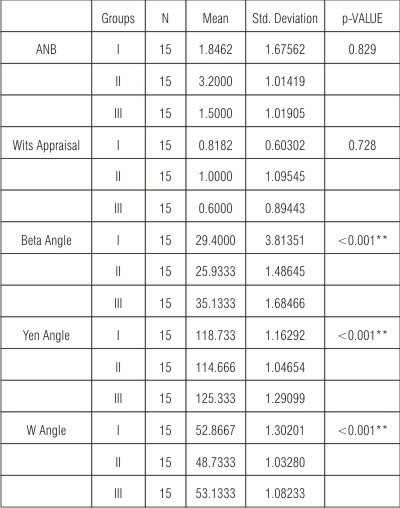Introduction
The evaluation of sagittal jaw relationship between maxilla and mandible has been one of the major problem in the field of orthodontics ,which is of prime importance in diagnosis and treatment planning .This is because of rotations of jaws during growth, vertical relationships between the jaws and reference planes, and a lack of validity of the various methods proposed for their evaluation 1,2,3,4. Numerous angular and linear measurements have been incorporated to assess the sagittal discrepancy between maxilla and mandible into various cephalometric analyses which could help the clinician to establish the most appropriate treatment plan. Appraisal by linear measurements has distinct advantages over angular measurements in that there are fewer variables to effect their accuracy and there is less error of measurement.5
Downs6 in 1948 introduced the A-B plane angle. Positive and negative signs were used to denote protrusion and retrusion of mandible. A few years later Riedel7 in 1952 introduced ANB angle and it became the most commonly used measurement since that time. However, both Down's and Riedel's methods are subject to error due to variations in the position of nasion which is not fixed during growth, and any displacement will directly affect the A-B plane angle and ANB angle.
As an alternative to ANB, Jacobson1 in 1975 introduced Wits appraisal. It relates points A and B to the functional occlusal plane. The distance between the points of intersection AO and BO is measured to describe antero-posterior relationship. In females AO should coincide BO, whereas in males BO should be 1mm ahead of AO.Though Wits appraisal avoids point N, accurate identification of functional occlusal plane is not easy or accurately reproducible, especially in mixed dentition patients. Secondly, any change in the angulation of functional occlusal plane, caused by either tooth eruption and dental development or orthodontic intervention, can profoundly influence Wits appraisal.
Baik and Ververidou3 introduced the beta angle in 2004.Though, it assesses sagittal discrepancies, it depends on points A and B, which are difficult to locate and point C in condyle which is not clearly visible either. Most recently introduced sagittal dysplasia indicator is YEN angle introduced by Neela et al8 (2009). Since it measures an angle between line SM and MG, rotation of jaw because of growth or orthodontic treatment can mask true basal dysplasia, similar to ANB angle.
To overcome these problems, Bhad 9 et al (2011) developed W-angle. It does not depend on any unstable landmarks or dental occlusion and would be especially valuable to assess true sagittal changes because of growth and orthodontic treatment. So the purpose of this study is to compare the various angles ANB angle, Wits appraisal, Beta angle, YEN angle and W-angle used to measure antero-posterior dysplasia and to find out which is the most reliable amongst them.
Material And Method
This study was conducted in the Department of Orthodontics and Dentofacial Orthopedics Himachal Dental College, Sundernagar. It consisted of 45 pretreatment lateral cephalograms of 10 to 25 year old individuals who had never undergone orthodontic treatment which were divided into 3 groups
Group I - Class I skeletal pattern group (n=15)
Group II - Class II skeletal pattern group (n=15)
Group III - Class III skeletal pattern group (n=15)
The following inclusion criteria was taken for the Class I skeletal pattern group (1) ANB angle of 1° to 3°, (2) Wits appraisal between 0 and -3 mm (3) Beta angle between 27 º - 35 º degrees, and (4) Yen angle between 117 º - 123 º (5) W-angle between 51º - 56 º and pleasant profile.
The following inclusion criteria was taken for the Class II skeletal pattern group
(1) The ANB angle was above 4° (2) Wits appraisal greater than or equal to -1 mm (3) Beta angle less than 27 º (4) Yen angle less than 117 º (5) W-angle less than 51º and the profile had a Class II appearance.
The following inclusion criteria was taken for the Class III skeletal pattern group (1) the ANB angle was less than or equal to 1° (2) Wits appraisal less than or equal to -4 mm (3) Beta angle more than 35º (4) Yen angle more than 123 º (5) W-angle more than 56 º and the profile had a Class III appearance.
Then the lateral cephalograms exposed with jaws in centric relation, lips relaxed, and the head in the Natural head position. The radiographs were obtained with Planmeca X-ray machine with model no: 2002(fig 1). All the cephalograms were recorded with the same exposure parameters and in the same machine. These cephalograms were traced, and ANB, Wits appraisal, and Beta angle, Yen angle and W-angle were measured to find the antero-posterior dysplasia and most reliable amongst them. (Fig 2)
 | Fig 1- Planmeca X-ray machine with model no: 2002
 |
 | Fig 2 – Lateral Cephalogram showing ANB angle, Wits appraisal , Beta angle , Yen angle , W-angle
 |
Statistical Analysis
The mean, standard deviation and P value were calculated for each parameter. ANOVA analysis was performed and highly significant differences were found in Beta angle, Yen angle and W-angle in all the three Groups (Group I, Group II, and Group III) (Table I)
 | Table I- Mean, Standard Deviation and p-Valve for the Three Groups
 |
Discussion
Clinicians with increasing frequency are treating malocclusions in conjunction with orthognathic surgery. A method of maxillomandibular assessment that provides accurate data on this relationship at an early age would be highly desirable.5 The most popular parameter for assessing the sagittal jaw relationship remains the ANB angle, but it is affected by various factors and can often be misleading.1 It has been suggested that although the apical base relationships were constant in all conditions, the ANB angle became either small or large and thus such a measurement was not reliable.10,11 So one must consider Bjork opinion that the human body constitutes a functional entity, no part of which can be varied without entailing some changes in other parts. Similarly, the facial skeleton and the dentition are functional parts of the skull as a whole. It follows, therefore, that variations in the bite will be largely related to cranial and facial structures."12
The result of this study shows that the ANB angle values are not significant (p-0.829) among three groups. This is in favour of the study conducted by Brown13, Chang 11 and Jacobson1, who claimed that any change in the SN plane would affect the ANB angle. This is also supported by Rotberg et al14 who also stated that nasion usually moves in anterior and slightly superior direction because of the growth increments on the cranial base plane passing through sella and nasion.
So when using the ANB angle, factors such as the patient's age, growth rotation of the jaws, vertical growth, and the length of the anterior cranial base (AP position of N) should be considered, which makes the interpretation of this angle much more complex (Jacobson, 1975)1.
Our study shows that Wits values were also non-significant (p - 0.728) among three groups. This is also supported by Moore et al 15 and Ishikawa et al16 who also stated that Wits appraisal although not affected by landmarks or jaw rotations; it still has the problem of correctly identifying the functional occlusal plane, which can sometimes be impossible, especially in mixed dentition. Furthermore, changes of the Wits measurement throughout orthodontic treatment might also reflect changes in the functional occlusal plane rather than pure sagittal changes of the jaws.
Our study shows that Beta angle values were statistically significant (p < 0.001) among three groups. This is also supported by Biak and Ververidou3 who stated that Beta angle does not depend on cranial landmarks or the functional occlusal plane and remain relatively stable even when the jaws are rotated. Another advantage of the Beta angle is that it can be used in consecutive comparisons throughout orthodontic treatment because it reflects true changes of the sagittal relationship of the jaws, which might be due to growth or orthodontic or orthognathic intervention. But it uses point A and point B, which can be remodelled by orthodontic treatment and growth.
Our study shows that Yen angle values were statistically significant (p < 0.001) among three groups. This is also supported by Neela et al 8 who stated that Yen angle depend on stable points S-midpoint of sella turcica, M- midpoint of pre-maxilla and G- center of largest circle that is tangent to the internal inferior, anterior, and posterior surfaces of the mandibular symphysis and so it is not influenced by growth changes and can easily be used in mixed dentition. But since it measures an angle between line SM and MG, rotation of jaw because of growth or orthodontic treatment can mask true basal dysplasia, similar to ANB angle.
Our study shows that W- angle values were statistically significant (p < 0.001) among three groups. This is also supported Bhad et al 9 who stated that this measurement does not depend on unstable landmarks or the functional occlusal plane. It uses three stable points-point S, point M, and point G and the angle is measured between a perpendicular line from point M to the S-G line and M-G line. The geometry of the W angle also has the advantage to remain relatively stable even when the jaws are rotated or growing vertically this is because of rotation of the S-G line along with jaw rotation, which carries the perpendicular from point M with it. Therefore, measurement of W angle is useful sagittal parameter in skeletal patterns with clockwise or counterclockwise rotation of the jaws as well as during transitional period when vertical facial growth is taking place.
Conclusion
It was concluded from the present study that Beta angle, Yen angle and W-angle are statistically significant angles to assess the sagittal jaw relationship between maxilla and mandible. On the other hand measurements such as ANB angle and Wits appraisal are misleading for the assessment of antero-posterior discrepancy.
References
1. Jacobson A: The "Wits" appraisal of jaw disharmony. Am J Orthod 1975; 67: 125-138.
2. Moyers RE, Bookstein FL, Guire KE: The concept of pattern in craniofacial growth. Am J Orthod 1979; 76: 136-148
3. Baik CY, Ververidou M: A new approach of assessing sagittal discrepancies: the Beta angle. Am J Orthod Dentofac Orthop 2004;126: 100-105
4. Nanda R 2005: Biomechanics and esthetic strategies in clinical orthodontics. Elsevier, St. Louis. pp. 38-73
5. Nanda R, Merrill RM : Cephalometric assessment of sagittal relationship between maxilla and mandible: Am J Orthod Dentofac Orthop 1994;105:328-44
6. Downs WB: Variations in facial relationships: Their significance in treatment and prognosis: Am J Orthod 1948;34:812-823
7. Riedel RA: The relation of maxillary structures to cranium in malocclusion and in normal occlusion. Angle Orthod 1952;22:142-145
8. Neela PK, Mascarenhas R, Husain A: A new sagittal dysplasia indicator: the Yen angle. World Journal of Orthodontics 2009;10:147-151
9. Bhad WA, Nayak S and Doshi UH: A new approach of assessing sagittal dysplasia: the W angle : European Journal of Orthodontic 2011:1-5
10. Freeman RS : Adjusting A-N-B angles to reflect the effect of maxillary position : Angle Orthod 1981;51:162-71
11. Chang HP: Assessment of anteroposterior jaw relationship: Am J Orthod Dentofac Orthop 1987;92:117-22
12. Oktay H : A comparison of ANB, WITS,AF-BF AND APDI measurements : Am J Orthod Dentofac Orthop 1991; 99: 122-8
13. Brown M : Eight methods of analyzing a cephalograms to establish anteroposterior skeletal discrepancy : Br J Orthod 1981:8;139-46
14. Rotberg S, Fried N, Kane J, Shapiro E : Predicting the " Wits appraisal from the ANB angle : Am J Orthod 1980:77;636-42
15. Moore RN, DuBois LM, Boice PA, Igel KA: The accuracy of measuring condylion location. Am J Orthod Dentofac Orthop 1989; 95: 344-347
16. Ishikawa H, Nakamura S, Hiroshi I, and Kitazawa S: Seven parameters describing anteroposterior jaw relationships: postpubertal prediction accuracy and interchangeability. Am J Orthod Dentofac Orthop 2000;117: 714-720 |